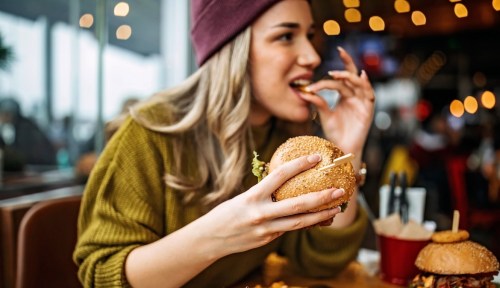Our editors independently select these products. Making a purchase through our links may earn Well+Good a commission
We’ve all been hit with stomach pain after eating at some point or another. You may feel a wave of extreme gas pain post-dinner, or even run to the bathroom to poop after eating. There’s usually a clear cause for stomachaches of this kind—like overdoing it on pizza and beer, or going back for that third (delicious) chocolate chip cookie. But other times, the culprit isn’t so clear.
Experts in This Article
gastroenterologist with Gastro Health in Plantation, Florida
gastroenterologist in Los Angeles, California
Postprandial pain—aka, a stomachache after you eat—can have a pretty wide range of possible causes, says Hector Gonzalez, MD, a gastroenterologist with Gastro Health in Plantation, Florida. But you can learn a lot about what might be going on by paying attention to your symptoms.
To get to the bottom of your stomachache (and hopefully, keep it from coming back), let’s take a look at some of the most likely causes. Plus, what you can do to soothe a sour stomach ASAP.
1. Overeating
It may seem obvious, but sometimes, the problem is as simple as just eating too much, Dr. Gonzalez says. Thankfully, it’s usually fairly easy to distinguish overeating pain from “there’s-a-problem-with-my-stomach” pain.
“Typically, a stomachache from overeating feels like a general discomfort or pain in your stomach because it’s overly full,” he explains. Typically, the effects of overeating wear off as your body digests what you ate.
2. Indigestion
Indigestion is stomach pain caused by trouble breaking down food, rather than just eating too much of it. And it feels a little different, too. “It might include symptoms like heartburn, bloating, or nausea and tends to manifest in the upper abdomen,” Dr. Gonzalez explains.
Sometimes indigestion is just from eating a specific food that’s tougher to digest (like fatty or fried foods). Other times, it’s a symptom of an underlying problem like acid reflux, a food intolerance, peptic ulcers, IBS, or gallstones—especially if you’re getting indigestion a lot, notes the Cleveland Clinic.
3. Acid reflux or GERD
Acid reflux happens when the acid from your stomach flows back into your esophagus—i.e., the tube that connects your stomach to your throat. The result can be heartburn, upper stomach pain after eating, chest pain, or regurgitating food into your throat or mouth (ew, we know). And if you get acid reflux more than twice a week, it’s called gastroesophageal reflux disease (GERD), per the Mayo Clinic.
Acid reflux usually strikes within a few hours of eating, especially after big or late meals. Common culprits like coffee irritate your stomach, but others include the following, per Johns Hopkins Medicine:
- Spicy foods
- Fried or fatty foods
- Cheese or other dairy products
- Tomato products
- Citrus
- Chocolate
- Peppermint
- Carbonated drinks
4. Food intolerance or sensitivity
Feel like you’re repeatedly getting stomachaches after eating one type of food? You could have a food intolerance, which happens when your stomach has trouble breaking down certain ingredients in said food. Common intolerances include the following, per the Cleveland Clinic:
- Lactose intolerance (a sugar found in dairy products like milk and ice cream)
- Gluten intolerance (a protein found in wheat, barley, or rye)
- Histamine intolerance (a naturally occurring chemical found in foods like cheese, pineapples, bananas, and chocolate)
Surprisingly, you could even have an avocado intolerance, among other foods you wouldn’t think twice about. These intolerances will often cause lower stomach pain after eating and hit shortly after consuming the offending food. The pain can also be accompanied by the following symptoms, per the Cleveland Clinic:
- Diarrhea
- Gas and bloating
- Nausea
- Heartburn
- Headaches
Keeping a food journal can help you narrow down which foods are causing digestive distress.
5. Celiac disease
Celiac disease is an inflammatory GI disorder where the immune system overreacts to gluten—the protein found in wheat, barley, or rye. A person with celiac disease will get stomach pain, diarrhea, bloating, and gas after eating foods high in gluten. But the condition is different (and much more serious) than a gluten intolerance, notes the Mayo Clinic.
While gluten intolerance can cause temporary stomach discomfort after eating gluten, the inflammation from celiac disease can cause long-term damage to a person’s GI tract, as well as lead to anemia, fatigue, and weight loss.
6. Stomach infection
Stomach bugs can run the gamut from a 24-hour flu to severe infections like those caused by the bacteria C. difficile or H. pylori. “In the case of an infection, stomach pain often feels sharp or cramping and can be accompanied by other symptoms like fever, nausea or vomiting, and diarrhea,” and can get worse after you try to eat, Dr. Gonzalez says. Intense and long-lasting symptoms often point to severe infection.
While antibiotics are typically the first line of treatment for stomach bugs caused by bacteria, those caused by viruses often just have to run their course.
7. Gastroparesis
Experts sometimes refer to this condition as “delayed gastric emptying,” which can clue you in to what it is: A disorder where your food moves from your stomach to your small intestine at a slower than normal rate, which can be caused by following conditions, according to the National Institute of Diabetes and Digestive and Kidney Diseases (NIDDK):
- Unmanaged diabetes
- Underactive thyroid
- Stomach infection
- Nervous system disorders
- Certain medications (like narcotics and antidepressants)
One of the classic symptoms of gastroparesis is getting full after just a few bites of food, or staying full for longer than normal after eating. “It often feels like a dull, aching sensation in the stomach area. It is usually accompanied by bloating and nausea,” says Dr. Gonzalez.
8. Ulcer
An ulcer—or a sore on the lining of your stomach—can pop up after an H. pylori infection or from long-term use of NSAID pain relievers (like ibuprofen). “The pain typically feels like a burning or gnawing sensation in the middle part of the stomach,” says Dr. Gonzalez. It can also hit with nausea, vomiting, bloating, or feeling uncomfortably full after you eat.
For some people, eating can make an ulcer pain worse, notes the NIDDK. But it’s more common to feel an uptick in pain when your stomach is empty, which temporarily eases up when you eat, Dr. Gonzalez says.
9. IBS
Irritable bowel syndrome (IBS) is a GI disorder that can cause abdominal pain, bloating, diarrhea, and constipation. It can be caused by many things, from increased muscle contractions in your gut to nerve hypersensitivity between your gut and brain, per the Mayo Clinic. But many people with IBS are also sensitive to FODMAPs—a group of carbohydrates that aren’t well-absorbed by the GI tract, per March 2023 research in Frontiers in Medicine1. This means, your IBS symptoms might be triggered by, or made worse, after eating those foods.
FODMAPs show up in a ton of different foods, including the following, per Johns Hopkins Medicine:
- Many fruits
- Vegetables
- Grains
- Nuts
- Dairy products
Most people who are FODMAP-sensitive only have issues with certain FODMAP foods—not all of them. A registered dietitian can guide you through a temporary elimination diet to help you pinpoint which foods you may need to avoid.
10. Crohn’s disease
A type of inflammatory bowel disease (IBD), Crohn’s disease causes chronic inflammation of the GI tract, leading to abdominal pain, diarrhea, weight loss, anemia, and fatigue. “The stomach pain often feels like cramping or aching and can be worse after eating,” says Dr. Gonzalez. That’s particularly true if you’re feeling a symptom flare and you eat foods that trigger your symptoms, which can include the following, per the Cleveland Clinic:
- Whole grains
- Beans
- Fibrous fruits and veggies
- Nuts and seeds
- Alcohol
- Caffeine
Treatment for Crohn’s is usually a combination of medications like immunosuppressants, corticosteroids, and anti-inflammatories. Your doctor may also prescribe antibiotics if they find an infection in your gut, or loperamide (Imodium) to help stop up diarrhea at home. And in severe cases, you may need surgery to help ease your symptoms, per the NIDDK.
11. Other conditions
Eating can potentially worsen symptoms caused by other digestive disorders, too, including the following, per Dr. Gonzalez:
- Appendicitis
- Gallstones or gallbladder disease
- Pancreatitis
- Liver disease
- Ulcerative colitis (a type of IBD)
- GI cancers, in rare cases
What the location of your stomach pain means
Sometimes where you feel discomfort can clue you in to what kind of stomach problem you’re dealing with. Here’s what certain locations could mean, per Dr. Gonzalez:
- Pain in your upper abdomen: This often points to a problem in your stomach, small intestine, gallbladder, liver, or pancreas.
- Pain below your belly button: This might have something to do with your appendix, colon, or bladder.
If you’re unsure about what the location of your pain means, reach out to your doctor.
How to treat stomach pain after eating
Getting a handle on your stomach pain (so it doesn’t come back) starts with addressing the underlying cause, Dr. Gonzalez points out. Managing pain caused by a certain food, for instance, will require limiting or avoiding the food, while you might need meds for other conditions like gastritis—aka, stomach inflammation—or Crohn’s disease.
That said, there are steps you can take to soothe your stomach in the meantime. Some options to consider include the following:
Take over-the-counter meds
If you’re dealing with gas, bloating, or stomach pain after eating too much, try over-the-counter (OTC) meds, recommends Dr. Gonzalez. Things like Gas-X can break up gas bubbles in your GI tract. And if you’ve got acid reflux, an antacid like TUMS or Rolaids can neutralize the acid in your stomach. And if you have lower GI issues like pain, cramping, or diarrhea? Go with Pepto Bismol, which has anti-inflammatory compounds to calm your gut.
Sip on herbal tea
Ginger has been shown to help ease nausea, cramping, abdominal pain, bloating, and gas, concluded a January 2019 review in Food Science & Nutrition2. That’s why a lot of people sip on ginger tea after they’ve eaten. You can try to steep slices of fresh, peeled ginger root in hot water, or buy ginger tea bags—we like Yogi Ginger Tea.
Peppermint tea is another solid pick. Peppermint has been shown to be highly effective for reducing abdominal pain and bloating, according to a January 2019 review in BMC Complementary Medicine and Therapies3. Steep fresh mint leaves in hot water to brew your own peppermint tea, or try Traditional Medicinals Peppermint Tea.

Yogi Tea Ginger Tea (6 pack) — $22.69

Traditional Medicinals Peppermint Tea — $4.92
Try diaphragmatic breathing
Taking slow, deep belly breaths puts gentle pressure on your GI tract, which can help get things moving along and release trapped gas, explains Wendi LeBrett, MD, a gastroenterologist based in Los Angeles, California.
The Cleveland Clinic recommends trying diaphragmatic breathing while lying down with your knees bent. Here’s how to do it:
- Place one hand on your upper chest and the other below your ribcage, so you can feel your breath move in and out.
- Breathe in slowly through your nose for several counts, allowing your diaphragm to fill with air. (The hand on your stomach should rise.)
- Tighten your stomach muscles to force the air out of your diaphragm. You should see the hand on your stomach start to fall.
- Repeat for five to 10 minutes.
Start walking
Moving your body can also move things along in your GI tract, so a post-meal walk is a good choice if you’re uncomfortable from eating too much, says Dr. LeBrett. Walking after eating might also help with heartburn prevention, found a January 2017 study in Digestion4.
It is possible to prevent stomach pain after eating?
It may be possible to prevent stomach pain after eating if you make a few lifestyle adjustments. Dr. Gonzalez’s top tips include the following:
- Eat smaller, more frequent meals to avoid getting uncomfortably full
- Try to limit or avoid foods that seem to trigger discomfort
- Eat slowly and chew your food thoroughly, to help support healthy digestion
And if you tend to get heartburn at night after eating, try to avoid eating within 3 or 4 hours of going to bed. You can also use a second pillow to prop your head up while lying down, too. Staying on an incline makes it harder for acidic contents in your stomach to flow back up into your esophagus, Dr. LeBrett says.
When to see a doctor
If you frequently get stomach pain an hour after eating (or longer), you should let your doctor know. This could signal an underlying health condition that needs to be checked out, Dr. Gonzalez says. It’s also best to seek medical care for other signs of bad gut health, like the following:
- Persistent nausea or vomiting
- Trouble swallowing
- Black or bloody stools
- Unintentional weight loss
- Intense fatigue, which could be a sign of anemia
FAQ
How do I know if my stomach pain is serious?
Stomach pain caused by a serious underlying issue (like an infection or a chronic condition) usually causes severe, persistent symptoms. It’s pretty typical to feel a little stuffed and uncomfortable after polishing off certain meals (cheeseburger and fries, anyone?). But it’s not normal to have pain or other symptoms after most of your meals. If this is happening to you, it’s important to reach out to your doctor to figure out the underlying cause.
What can I drink after a meal to help digestion?
Try ginger or peppermint tea, suggests Dr. LeBrett. Both have properties that relax the muscles of the GI tract, which can help speed up digestion, or release trapped gas that’s making you bloated. Some people also enjoy prebiotic soda or just drinking a plain ol’ glass of H2O to help move their bowels along.
—reviewed by Jennifer Logan, MD, MPH
Nordin, Elise et al. “FODMAPs-Do they really affect IBS symptoms?.” Frontiers in medicine vol. 10 1123576. 2 Mar. 2023, doi:10.3389/fmed.2023.1123576
↩︎Nikkhah Bodagh, Mehrnaz et al. “Ginger in gastrointestinal disorders: A systematic review of clinical trials.” Food science & nutrition vol. 7,1 96-108. 5 Nov. 2018, doi:10.1002/fsn3.807
↩︎Alammar, N et al. “The impact of peppermint oil on the irritable bowel syndrome: a meta-analysis of the pooled clinical data.” BMC complementary and alternative medicine vol. 19,1 21. 17 Jan. 2019, doi:10.1186/s12906-018-2409-0
↩︎Mori, Hideki, et al. “Gender difference of gastric emptying in healthy volunteers and patients with functional dyspepsia.” Digestion, vol. 95, no. 1, 2017, pp. 72–78, https://doi.org/10.1159/000452359.
↩︎
Sign up for the Well+Good SHOP Newsletter
Get exclusive deals on wellness, beauty, fitness, and food products that have been hand-picked by our editors.
Got it, you've been added to our email list.











